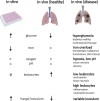Therapeutic Challenges of Non- Aspergillus Invasive Mold Infections in Immunosuppressed Patients
- PMID: 31481441
- PMCID: PMC6811444
- DOI: 10.1128/AAC.01244-19
Therapeutic Challenges of Non- Aspergillus Invasive Mold Infections in Immunosuppressed Patients
Abstract
While Aspergillus spp. remain the major cause of invasive mold infections in hematologic cancer patients and transplant recipients, other opportunistic molds, such as Mucorales, Fusarium, and Scedosporium spp. are increasingly encountered in an expanding population of patients with severe and prolonged immunosuppression. High potential for tissue invasion and dissemination, resistance to multiple antifungals and high mortality rates are hallmarks of these non-Aspergillus invasive mold infections (NAIMIs). Assessment of drug efficacy is particularly difficult in the complex treatment scenarios of NAIMIs. Specifically, correlation between in vitro susceptibility and in vivo responses to antifungals is hard to assess, in view of the multiple, frequently interrelated factors influencing outcomes, such as pharmacokinetic/pharmacodynamic parameters determining drug availability at the site of infection, the net state of immune suppression, delay in diagnosis, or surgical debulking of infectious foci. Our current therapeutic approach of NAIMIs should evolve toward a better integration of the dynamic interactions between the pathogen, the drug and the host. Innovative concepts of experimental research may consist in manipulating the host immune system to induce a specific antifungal response or targeted drug delivery. In this review, we discuss the challenges in the management of NAIMIs and provide an update about the latest advances in diagnostic and therapeutic approaches.
Keywords: Fusarium; Lomentospora; Mucor; Rhizopus; Scedosporium; amphotericin B; azole; fusariosis; isavuconazole; mucormycosis; posaconazole; scedosporiosis; voriconazole.
Copyright © 2019 American Society for Microbiology.
Figures


References
-
- Kontoyiannis DP, Marr KA, Park BJ, Alexander BD, Anaissie EJ, Walsh TJ, Ito J, Andes DR, Baddley JW, Brown JM, Brumble LM, Freifeld AG, Hadley S, Herwaldt LA, Kauffman CA, Knapp K, Lyon GM, Morrison VA, Papanicolaou G, Patterson TF, Perl TM, Schuster MG, Walker R, Wannemuehler KA, Wingard JR, Chiller TM, Pappas PG. 2010. Prospective surveillance for invasive fungal infections in hematopoietic stem cell transplant recipients, 2001–2006: overview of the Transplant-Associated Infection Surveillance Network (TRANSNET) Database. Clin Infect Dis 50:1091–1100. doi:10.1086/651263. - DOI - PubMed
-
- Neofytos D, Horn D, Anaissie E, Steinbach W, Olyaei A, Fishman J, Pfaller M, Chang C, Webster K, Marr K. 2009. Epidemiology and outcome of invasive fungal infection in adult hematopoietic stem cell transplant recipients: analysis of Multicenter Prospective Antifungal Therapy (PATH) Alliance registry. Clin Infect Dis 48:265–273. doi:10.1086/595846. - DOI - PubMed
-
- Pappas PG, Alexander BD, Andes DR, Hadley S, Kauffman CA, Freifeld A, Anaissie EJ, Brumble LM, Herwaldt L, Ito J, Kontoyiannis DP, Lyon GM, Marr KA, Morrison VA, Park BJ, Patterson TF, Perl TM, Oster RA, Schuster MG, Walker R, Walsh TJ, Wannemuehler KA, Chiller TM. 2010. Invasive fungal infections among organ transplant recipients: results of the Transplant-Associated Infection Surveillance Network (TRANSNET). Clin Infect Dis 50:1101–1111. doi:10.1086/651262. - DOI - PubMed
Publication types
MeSH terms
Substances
LinkOut - more resources
Full Text Sources
Miscellaneous

